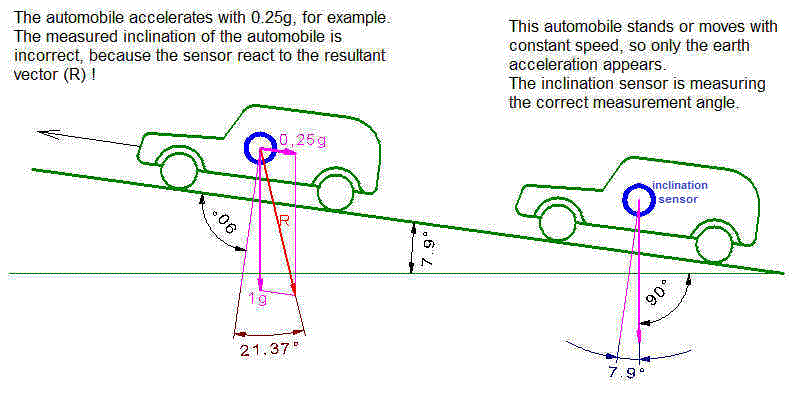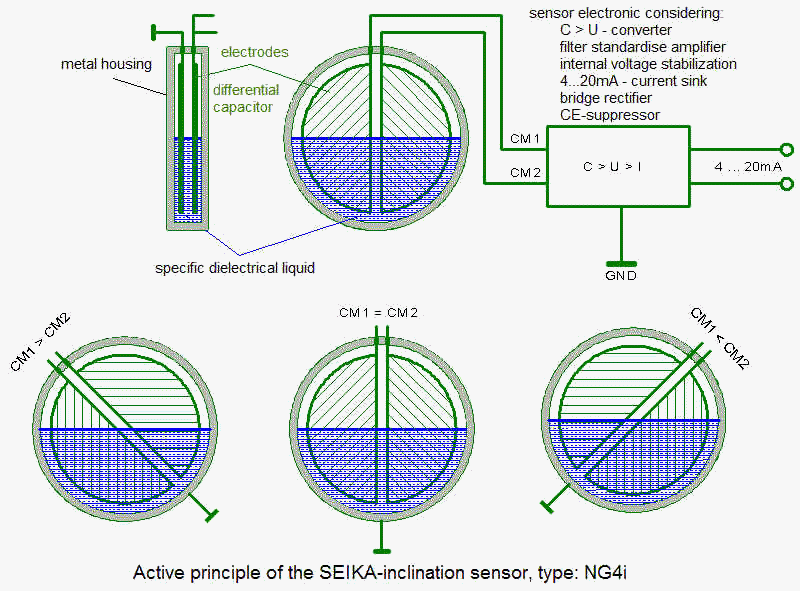
| Frequently asked questions to slope Measurement (FAQ) |
Which influences have acceleration forces (e.g. in vehicles) to the result of measurement of an inclination sensor?
At the deviation measurement our inclinometers measure the angle of the vector of the acceleration due to gravity proportional to the item in a vertical level. If there are added further accelerations in other directions, e.g. horizontal acceleration (speeding up or braking) or centrifugal acceleration (driving along curves) the resulting vector will deviate the vector of acceleration due to gravity. Than the inclination sensor (independend of type or make) will respond to the resulting vector and react with a measuring error. If the disturbing vector should lie accurately right-angeled to the plane of measurement or the plane of measurement is crosswise than it is not registered (in ideal case). SEIKA N or NG inclinometers react during a bank of 45° with a measuring error smaller 1% of the measured value. The SEIKA NB and B sensors are transversacceleration insensitive.

The left car accelerates e.g. with 0,25g. The measured vehicle inclination is incorrect, because the sensor reacts on the resulting vector (R).
The right vehicle stands or moves with constant speed, i.e. no acceleration accept acceleration due to gravity. The inclination sensor measures the correct angle of the vehicle to the horizontal level.
(and not toward acceleration due to gravity) than this will always form a resulting vector with acceleration due to gravity and lead to measuring errors. If disturbing acceleration has a vector in the plane of measurement In this case it makes no difference wich inclination sensor one measures.
Which ways out are possible ?
1. Because the acceleration due to gravity is a static size (frequency zero) and the disturbing accelerations are often dynamic (frequency larger zero) one can separate both sizes possibly by suitable low-pass filtering. An exact view of the expected measuring dynamic and the frequency of the disturbing acceleration is necessary. The larger the difference between the measured frequency and the disturbing acceleration, much better both can seperate. But frequency filters cannot be realized with straight characteristic.
2. Perhaps one has to take much more expensive and more complex giro systems, perhaps in combination with acceleration and/or inclination sensors. But this systems hold there own problems.
3. Also possible are measurements to a external reference system in a limited reference area.
In any case important is an exact analysis of the measuring problem.
The most favorable attachment place is the pivot of the item!
Above or below the pivot there occur more or less large horizontal transverse accelerations, wich lead to measuring errors (see above). This isn´t important , if the item is moving slowly (quasi-static measuring signal, means the disturbing acceleration is to neglect in relation to acceleration due to gravity). In this case the measuring error is minimal.
Possible measuring errors, wich result from a rotation acceleration of the item, are avoidable by electrical interconnection of two inclination sensors, wich are fastened opposite each other in the same distance from the pivot (one above and one below the pivot). The positive measuring error and the negative measuring error cancel each other out and the reading is doubling.
Also in this cases the exact analysis of the measuring problem is necessary.
No ! - (Even some manufacturers advertise with information like &bdquoresolution infinitely&ldquo. This is nonsense!)
The resolution expresses the possible changes of the measured parameter. Mostly it means the signal change wich is larger than a interference signal (electronic noice) and other error influences (e.g. hysteresis).
The resolution is important for acquisition of small angle changes (fluctuation of a crane, a bridge etc. under dynamic load effect under essentially unchanged enviromental conditions like temperature, operating voltage etc.).
The measuring accuracy expresses the maximal deviation of the measured value from the real value under concrete operation conditions. Because every measuring system depents on different influences, they have to be known for estimate measuring accuracy.
Error information from wich one calculate the accuracy are most listed in the data sheets but not all possible influences can be considered. In some special cases it can be necessary to take individual investigations about accuracy of the sensor.
But usually it is sufficent to consider the influence of temperature changes, the &bdquomain enemy of the measurement technique&ldquo. It is plausible that the measuring error under room conditions will be smaller than at an outdoor crane boom with the complete spectrum of automative temperature range or at a ram with extreme vibrations or in a nuclear installation with high radioactive radiation.
N o !
No! For that kind of work a compass is suitable. Because of that a triaxial inclinometer does not exist.
N o !
Despite of perfection in electronics, progressive measuring signal processing and permanent improved technical possibilities, there are always measuring errors and problems, wich demand on adaption of the requests or on conditions to the given possibilities.
For this reasons everytime it is important to make an exact individual analysis of the respective measuring task.
What is the effective method of the SEIKA liquid inclinometer?

The special composition of the dielectric liquid guarantees an optimal temperature behaviour, high long term stability, hysteresis free measuring value, minimal linearity errors, short response times and much more positive properties of the sensors. In connection with the sensor-integrated electronics there is a high electromagnetic compatibility.
With a liquid based inclinometer the horizon is scanned by the liquid. That can happen optically, resistiv, magnetically or capacitively. Indepent of how the liquid is scanned, all inclinometer have a common characteristic: The fluid level places itself always horizontally in, indepent of whether the gravity is large or small. That means one can measure exact with such a sensor at different places, at equator or North Pole, on high mountains or see-bottom, on moon or Mars, everytime the reult is correct.
An inclinometer with spring-mass system (e.g. all micromechanical inclinometer) scans the displacement on a spring. The displacement of the mass is for the first depend of the spring constant of the suspension and for the second depend of the quantiy of the gravity on measuring place.
If the gravity is different than the displacement is different and therefore different measuring values of inclination angle result. For exact measuring such a sensor must be adapted to the gravity of the measuring place and can not be used universally.
A special variant of the spring-mass system is the pendulum. This is a spring-mass system with extreme small spring constant. The resetting force-free pendulum behaves similary to the liquid inclinometer with its advantages concerning the influence of the force of gravity. A further advantage of liquid inclinometers exists in the unlimited measuring range because there is no sinusodial connection between angles of inclination and output signal. The method of an additional computational measured value correction at large measuring ranges, practiced by some manufacturers, makes at large angles compulsorily large measuring errors.
At small angles of inclination and when the gravity is adjusted, spring-mass systems can be favourable. At spring-mass systems (systems from silizium) are restrictions at measuring sensitivity and signal/noice ratio.
With liquid inclination sensors there are mainly used resistive and capacitive procedures.
During resistive scanning the change of the resistance of a conductive liquid is measured with different large contact area, caused by different inclination.
During capacitive scanning the changing capacity is measured, wich results if a dielectric liquid fills more or less the area between two condenser electrodes because of different inclination.
The measuring of the resistance of a liquid (at resistive scanning) everytime is connected with barrier region problems between the liquid and measuring electrodes and electrolysis problems by current flow in the liquid. The disadvantage of it is the ageing and the relative high unstable temperature drifts, because of the temperature changable resistance of conductive liquids.
With capacitively scanned dielectric liquids these problems do not arise, so aging and unstable temperature drifts are completely missing. The disadvantage of the complicated electronics plays no more role today because we are in the situation to integrate all important functional elements of sensor signal processing on a small silicon chip.
Yes ! But unfortunately not all.
In principle one can correct all biased errors, wich is to a large part realized in the sensor. The temperature drift of the primary transducer, caused of the temperature-dependent changes of the dielectric constant of the measuring liquid is corrected in most SEIKA inclinometers. Also deviations by production are corrected.
Not to correct are storastic errors, i.e. coincidental dispersions of the measuring signal wich are caused e.g. by the inevitable electronic noice. Such errors often are the bounds of possibility.
Generally principle: Sensors are individuals mostly in the hard external operation and every measuring task is a unique with special conditions. This makes the sensor measurement difficult and interesting! |
More questions to this topic you can send to :
Dr.-Ing. Hans-Hermann Seidel (seidel@seika.de)
Reproduction in whole or in part, only with regard to this source!
SEIKA Mikrosystemtechnik GmbH - Söllerweg1- D 87487 Wiggensbach - email: seika@seika.de - Tel.+49 8370 9290070 - FAX:+49 8370 9290079
H118S